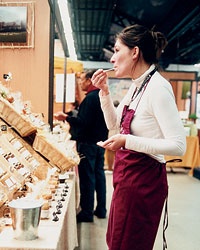 Marie Hennechart Sampling the sweet milk confiture produced by Mille Pattes, a farm in Languedoc-Roussillon.
Where can you find figs from Provence, chèvre from the Pyrenees, and almost any French comestible you can imagine?Among the farmers and producers at the Pari Fermier food fair.
Marie Hennechart Sampling the sweet milk confiture produced by Mille Pattes, a farm in Languedoc-Roussillon.
Where can you find figs from Provence, chèvre from the Pyrenees, and almost any French comestible you can imagine?Among the farmers and producers at the Pari Fermier food fair.
It used to be that the only option open to gastronauts wanting to taste and buy a broad range of handcrafted food products from the six corners of France was to clear their calendars for five years, purchase an atlas, and take to the road. Pari Fermier has changed the game. Held six times a year in and around Paris, the fair assembles in one spot up to 200 independent, small-scale producers from some 21 regions, including makers and growers of honey from the Auvergne; cider from Normandy; spice cake from Languedoc-Roussillon; Espelette pepper from the Pays Basque; lentils from the Berry. When the next Pari Fermier opens in Paris on October 17 for four days (the one after that is December 19–21, in Vanves), chefs will give demonstrations in a kiosque du goût using ingredients supplied by exhibitors. There’ll even be a complimentary porter to help load your purchases into a taxi.
The event has the insider-y, narrow-and-deep feel of a professional food fair, with the friendly, leisurely difference that it was conceived for the public. The seven-euro admission buys the right to sample everything that is sampleable (the guinea fowl and Aveyron veal roasts will make you wish you knew someone in Paris with an oven). With patience you can make a meal grazing from stand to stand, if you don’t mind abusing the generosity of the sellers. Tables, benches, and a bar serving coffee are set up to encourage people to buy small portions of the foods on display and sit down to lunch. At one recent Pari Fermier I composed a lovely meal of Philippe Labadie’s creamy oysters; Raymonde and Dominique Baële’s silky duck ham; dried lamb sausage, unknown to me and delicious, from La Ferme de Jaugeny; and prunes, fragrant and fleshy, from Pruneaux Cabos. The only thing I tried that I hope never to see again is Mon Copain J.P.’s seaweed tartare.
While 60 percent of the participants have farms or other operations you can visit, a quarter also offer lodgings. Information about visits and rooms is usually included on cards or brochures, so it pays to pick them up. Not every item at the fair is organic, but all producers adhere to an eight-point sustainable-agriculture charter, are vetted with on-site inspections, and are required to personally man their stands to conduct tastings, answer questions, and smile. In this way you can meet the faces behind the fig syrup, chutney, and compote of Les Figuières, which cultivates more than 150 varieties of the fruit in Provence; the cassis vinegar and mustard of La Ferme Fruirouge, in Burgundy; the handpicked walnuts of OccitaNoix, in the Périgord; the brine-washed goat cheese of Maison Lanset, in the Pyrénées-Atlantiques; the tender free-range escargots, raised on a diet of wild botanicals, of L’Escargotière Bonvalot in the Jura; and the unctuous whole-sheep’s-milk confiture (for spreading on crêpes) of Mille Pattes, in the Lozère.
If there’s a better way of spending an afternoon in Paris, I don’t know what it is.
October 17–20: Espace Champerret, Rue Jean Oestreicher, Porte de Champerret, 17th Arr. December 19–21: Villages des Terroirs Fermiers à Vanves, Place de la République, in front of Église St.-Rémi, Vanves; 33-1/44-54-90-06; parifermier.com.
There are up to 200 producers and farmers at the Pari Fermier food fair, held six times a year. How to decide which to visit?Below, a handful of our favorites.
L’Escargotière Bonvalot: Escargots
La Ferme Fruirouge: Cassis vinegar and mustard
La Ferme de Jaugeny: Lamb sausage
La Ferme du Leconet: Seasonal, organic vegetables; goat cheeses
Les Figuières: Fig syrup, chutney, and compote
Les Ruchers d’Enchanet: Honey and honey products
Maison Lanset: Goat cheeses
Maraÿn de Bartassac: Cow’s-, goat’s-, and sheep’s-milk cheeses
Mille Pattes: Sheep’s-milk confiture
OccitaNoix: Walnuts; walnut oils and pastes
Philippe Labadie: Oysters
Pruneaux Cabos: Prunes
Raymonde and Dominique Baële: Duck ham